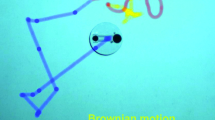Summary
-
1.
Locust forewing muscles were recorded whilst the animal was free to manoeuvre.
-
2.
First and second mesothoracic basalars (depressors) and first and second tergosternal muscles (elevators) show changes in firing patterns associated with turning.
-
3.
The phase between left and right first basalars was subject to large and rapid changes. The phase between left and right first tergosternals changed less markedly.
-
4.
Ipsilateral first and second basalars were not tightly linked in either burst length or phase.
-
5.
Ipsilateral first and second tergosternals were very tightly linked in burst and phase changes.
-
6.
The mesothoracic subalar changed its firing pattern less than any other of the muscles studied.
-
7.
The results are discussed in relation to known pathways in the flight motor system.
Similar content being viewed by others
References
Baker, P.S.: Flying locust visual responses in a radial wind tunnel. J. Comp. Physiol.131, 39–47 (1979a)
Baker, P.S.: The wing movements of flying locusts during steering behaviour. J. Comp. Physiol.131, 49–58 (1979b)
Baker, P.S., Cooter, R.J.: The natural flight of the Migratory Locust,Locusta migratoria L. I. Wing movements. J. Comp. Physiol.131, 79–87 (1979a)
Baker, P.S., Cooter, R.J.: The natural flight of the Migratory Locust,Locusta migratoria L. II. Gliding. J. Comp. Physiol.131, 89–94 (1979b)
Burrows, M.: The role of delayed excitation in the co-ordination of some metathoracic flight motoneurons of a locust. J. Comp. Physiol.83, 135–164 (1973)
Burrows, M.: Monosynaptic connexions between wing stretch receptors and flight motoneurons of the locust. J. Exp. Biol.62, 189–219 (1975)
Camhi, J.M.: Locust wind receptors. III. Contribution to flight initiation and lift control. J. Exp. Biol.50, 363–373 (1969)
Camhi, J.M.: Yaw correcting postural changes in locusts. J. Exp. Biol.52, 519–531 (1970a)
Camhi, J.M.: Sensory control of abdomen posture in flying locusts. J. Exp. Biol.52, 532–537 (1970b)
Cooter, R.J.: Visually induced yaw movements in the flying locust,Schistocerca gregaria (Forsk.). J. Comp. Physiol.131, 67–78 (1979)
Dugard, J.J.: Directional change in flying locusts. J. Insect Physiol.13, 1055–1063 (1967)
Goodman, L.J.: The role of certain optomotor reactions in regulating stabilily in the rolling plane. J. Exp. Biol.42, 385–407 (1965)
Möhl, B., Zarnack, W.: Activity of the direct downstroke flight muscles ofLocusta migratoria during steering behaviour in flight. II. Dynamics of the time shift and changes in the burst length. J.Comp. Physiol.118, 235–247 (1977)
Snodgrass, R.E.: The thoracic mechanism of a grasshopper and its antecedents. Smithson. Misc. Collect.82, no. 2, 1–111 (1929)
Tyrer, N.M., Altmann, J.S.: Motor and sensory flight neurons in a locust demonstrated using cobalt chloride. J. Comp. Neurol.157, 117–138 (1974)
Waldron, I.: Neural mechanisms by which controlling inputs influence motor output. J. Exp. Biol.47, 213–228 (1967)
Wilson, D.M.: Inherent asymmetry and reflex modulation of the locust flight motor pattern. J. Exp. Biol.48, 631–641 (1968)
Wilson, D.M., Weis-Fogh, T.: Patterned activity of coordinated motor units. J. Exp. Biol.39, 643–667 (1962)
Zarnack, W., Möhl, B.: Activity of the direct downstroke muscles ofLocusta migratoria during steering behaviour in flight. I. Patterns of time shift. J. Comp. Physiol.118, 215–233 (1977)
Author information
Authors and Affiliations
Additional information
I thank Drs R.J. Chapman, R.J. Cooter and L.J. Goodman for much support and criticism during this work, and Prof. M. Gewecke and Dr P.L. Miller for many helpful comments on the manusrcipt.
Rights and permissions
About this article
Cite this article
Baker, P.S. The role of forewing muscles in the control of direction in flying locusts. J. Comp. Physiol. 131, 59–66 (1979). https://doi.org/10.1007/BF00613084
Accepted:
Issue Date:
DOI: https://doi.org/10.1007/BF00613084




